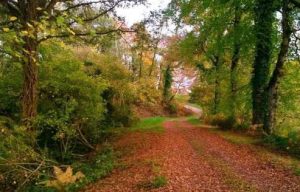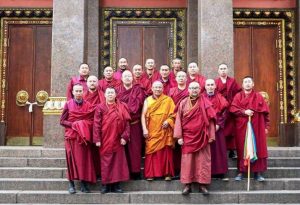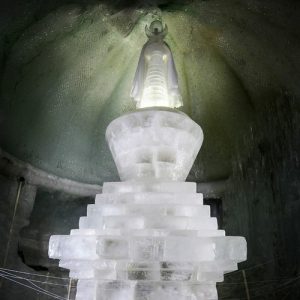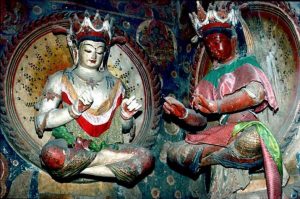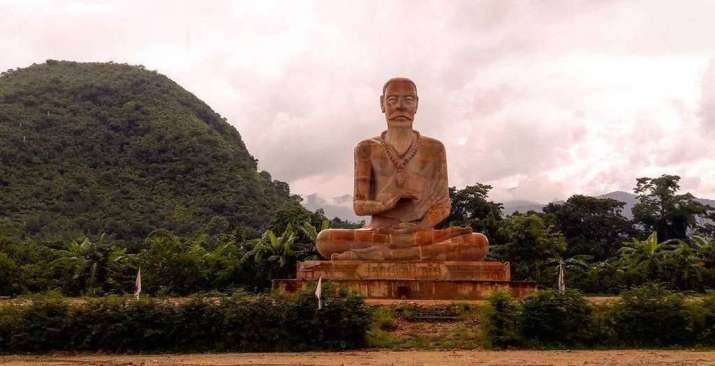
Jivaka was a renowned physician in ancient India and a contemporary of the Buddha. While he is not well known beyond the Theravada world, his iconography appears in various locations in Thailand and he is often invoked as a patron of healing, medicine, and wellbeing (with his statue appearing in yoga studios and wellness spas).
The eighth chapter of the Mahavagga of the Vinaya Pitaka details the life of Jivaka. He was the best disciple of the physician Atreya, who possessed an unparalleled ability to read the pulse of a patient and was known for his ability to perform complex operations. Atreya was also a great master in the herbal department of the ancient Taxila academy. Today, Taxila is an important archaeological site in Punjab, Pakistan.
Jivaka completed his first seven years of learning under Atreya. One story concerning his wisdom during his time in medical school is that his master had asked him to find a plant that was inappropriate for medicinal use. Jivaka walked through the forest but returned to Taxila empty-handed. He went to Atreya and told him that he could not find anything. His teacher was happy and said that Jivaka’s learning was complete. Afterward, Jivaka would go on to heal countless dying and afflicted people, regardless of their socio-economic status or spiritual affiliation.
Jivaka was also the personal physician of the Buddha. There is a saying that the Buddha did not make him monk rather he accepted him as his lay disciple because the Buddha wanted him to remain free to tend to sick people.
Jivaka was also instrumental in suggesting that the Buddha allow monks to accept readymade robes. Until this point, the Buddha had worn pamsukula robes (robes sewn from rags taken from cemeteries or cremation grounds), which was true to the monastic spirit yet harmful to the monks’ health. Jivaka looked after these men and understood that the true causes of their illnesses came from wearing unhygienic cloth collected from cemeteries. It was probably out of health concerns that Jivaka offered this suggestion, but he became effectively the first layman who offered complete robes to monks.
At one point, Jivaka was offered a piece of cloth from King Pajjota. Jivaka donated this cloth to the Buddha and requested the Buddha to allow the fraternity of monks to wear robes donated by laypeople. Upon accepting the cloth, the Buddha gladdened Jivaka through a teaching. Immediately after having delivered the sermon, the Buddha addressed the gathering: “Monks! I permit the wearing of robes offered by the laity. He who likes may wear pamsukula robes; he who likes may accept lay robes. Whether you are pleased with the one or the other sort of robes, I approve it.”
The Mahavagga also records that the Buddha suggested many kinds of medicines to cure diseases. For example, when monks were suffering from autumnal illnesses, which caused vomiting, the Buddha advised them to switch to a diet of fat, ghee, oil, honey, and molasses. He also said that if anyone was suffering from scabs, itching, scars, or spleen pain, he should try applying dung, clay, and pudding-colored powder to the affected area.
If anyone was suffering from a headache, he was instructed to smear tobacco leaf powder on the head or through the nose by smoking a pipe. Anyone suffering from arthritis should be massaged with aromatic oil. People who were continuously sweating could try four remedies: sleeping on the leaves of various trees that absorb sweat, applying sand and soil, massaging oil on the body, and wiping the body with a damp cloth, throwing water of various tropical leaves to sweat out, or having a hot water massage.
The Buddha also suggested many items from which medicine could be made. Those items included animal products, roots from vegetables and fruits such as terminalia chebula, ginger, fruits, vegetables, pepper, chillies, as well as marine salt, black salt, granulated salt, and bit salt. He asked sick people to consume molasses and drink clean water. Although many of the suggested items might not be used as modern medicines, they are still used in traditional medicinal systems and regional disciplines of Ayurveda.
In the Mahavagga, the above medicines are mostly recommended for monks. They should be seen in the context of a monastic community in a pre-literate society that was concerned with specific health issues in ancient India: leprosy, ulceration, eczema, consumption, and epilepsy. The majority of the Mahavagga’s medical solutions were tailored mostly to problems of skin or stomach hygiene, blood, and bodily fluids.
In contemporary times, a number of published reports have warned that many monks are obese or experiencing problems with their legs, as a result of diabetes and other health issues. Jongjit Angkatavanich, a health and nutrition expert at Bangkok’s Chulalongkorn University, demonstrated that in Thailand, an estimated 42 per cent of monks have high cholesterol levels, 23 per cent suffer from high blood pressure, and more than 10 per cent are diabetic. Monks often consume sweetened beverages such as sodas as these are frequently offered to them by lay devotees, contributing to the obesity crisis. Fortunately, some monks have begun paying more attention their diets while exercising in the privacy of their rooms. In Sri Lanka, the foods offered to monks cause significant health problems due to high sugar and fat levels. The problem has become so serious that the Sri Lankan Ministry of Health has wards in every state hospital devoted to treating monks and other clergy.
It is obvious that Buddhist practice focuses on meditation, which stresses purification of mind. Yet the Buddha was also greatly concerned about physical health. Therefore, in the Dhammapada 208, the Buddha is said to have taught: “Health is highest gain.” From the life of Jivaka, we can see that he not only cared for the Buddha, but also expressed concern for the monastic community. While offering food will always generate merit when donated to sincere monastic practitioners, the nutritional qualities (or lack thereof) of such foods are also an important consideration factoring in to the merit of the donation.
See more
Why Thailand is putting its Buddhist monks on a diet (CNN)
Sri Lanka Announced Plans To Draw Up New Guidelines For Donating Food To The Monks (Colombo Telegraph)




